The best Python frameworks you can use in web development

Python web development has been around for quite some time. As a result of that, numerous great Python frameworks were created to make your life in web development a lot easier.
And speaking of easy, that is exactly how we would describe Python for web development. It is a very readable language using the basic concepts of an object-oriented programming language (OOP). Thanks to its unique syntax, it is much easier to learn and use compared to other programming languages such as Java, C++, and C.
However, with the right Python framework, things can get even easier. Python frameworks provide a structure to help developers create the apps without having to build every single detail from scratch.
Luckily, Python supports a wide variety of useful frameworks that you can use in web development. However, let’s answer some basic framework-related questions first.
What is a Web Framework?
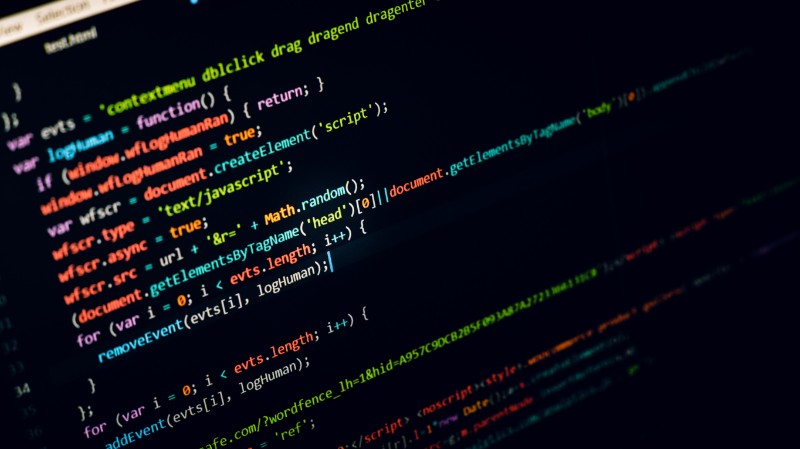
A web framework is an arrangement designed to support the development of web applications and web APIs. It provides a standard way to build apps while it aims to automate the overhead associated with common activities performed in web development. It comes with many reusable functionalities.
What is the Framework’s Purpose?
Python web frameworks have two main purposes:
- To simplify the process of creating web apps while achieving the best possible results
- To save time
Why do we use Frameworks?
Website frameworks are very useful for a number of reasons:
- They allow you not to build everything from scratch
- They hide startup things such as creating autoload files, session files, index files etc.
- They give better functionality to process requests
- They follow the latest patterns
- They allow you to attach useful third-party resources
How to choose the right Framework?
Since there are many web application frameworks out there, it might get a bit confusing and hard to decide which one is the right one for you. So when picking the Python web framework of your choice, there are several things to consider.
First, you should take a look at the size and complexity of your project. If you want to build a small and fairly simple app, you should consider using a microframework. If, on the other hand, you want to create a large system full of all kinds of features and requirements, you will need a full-stack framework to get the job done right.
You can find more information about different framework types here. However, keep in mind that the final decision should come from your understanding of your goals and the tasks you want to simplify.
Another thing to keep in mind is the fact that sometimes, a web application framework can stand in the way of web development. The thing is that frameworks usually come with certain limitations. You can either find your ways of working around them or discard them entirely instead of fighting against your own creative freedom.
Full-Stack Frameworks
The full-stack frameworks provide complete support to developers, including elements such as template layouts, form generators, form validation, and more. Let’s take a look at the list of frameworks of this kind that are commonly used with Python.
Django
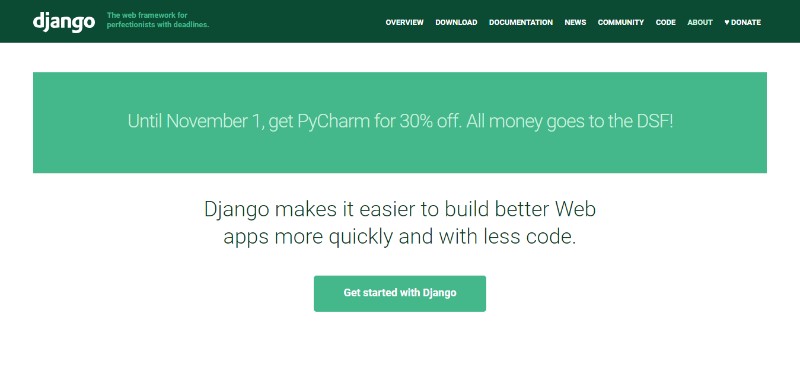
Many people who decide to build a Python web app decide to use the Django framework. Some would even argue that it is the best web framework because it is very easy to use while also being entirely free of charge.
It was officially released in July 2005 and it has been one of the developers’ favorite ever since. It helps them create complex code and apps easily, it requires much less time compared to other frameworks, and it uses the DRY (don’t repeat yourself) and a model-view-template architectural pattern.
In addition to that, it comes with a huge collection of libraries written in Python, and it emphasizes efficiency, the reusability of components, and less code. The key features include the URL routing, template engine, ORM (object-relational mapper), database schema migrations, and authentication mechanism.
It supports numerous databases including but not limited to PostgreSQL, MySQL, SQLite, and Oracle. As a result of that, the transferring of the code from one database to another is easier than ever.
Some of the most renowned companies believe it is the best Python framework and they use it for their popular web apps, for example, Pinterest, Instagram, The Washington Times, Mozilla, Disqus, Bitbucket, and more.
Web2py
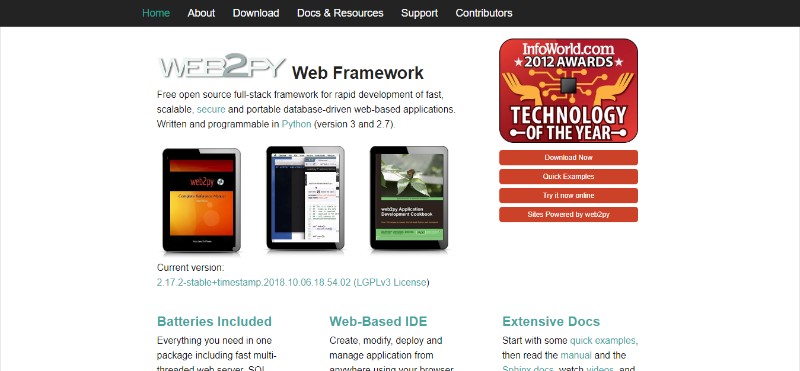
Web2py is another name on the list of web frameworks you should check out if you want to build a Python website. It is one of the open-source and free Python frameworks and it allows you to create dynamic Python web content.
It comes with many useful functionalities, including the debugger, a code editor, and a deployment tool that will help you not only debug code but also maintain your Python web application. Whenever an error occurs, you will get a ticket to keep track of the errors to solve.
The key features include:
- Support for Windows, Unix/Linux, Mac, Google App Engine, and many other platforms
- No additional installation and configuration
- Built-in components to handle HTTP requests, HTTP responses, cookies, and sessions
- Ability to read multiple protocols
- Security against the common threats such as cross-site scripting, injection flaws, and execution of infected files
- Follows model-view-controller (MVC) pattern
- Support for role-based access control and internationalization
- Allows users to embed jQuery for Ajax and UI effects.
TurboGears
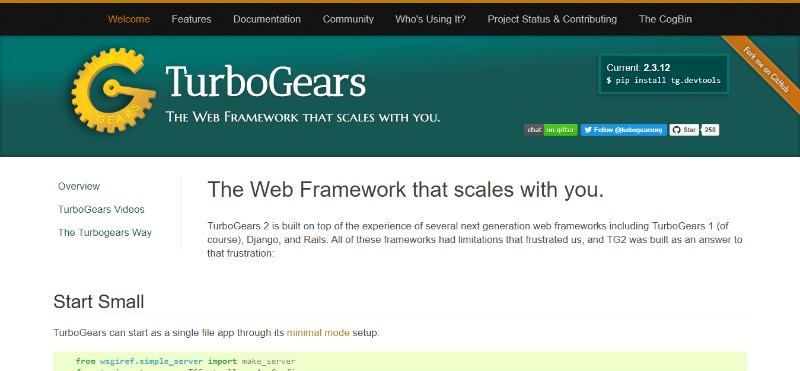
TurboGears is an MVC framework for Python web programming of apps based on several WSGI components such as SQLAlchemy, Ming, Repoze, template engines such as Genshi, Kajiki, Cheetah, Myghty, and a number of libraries and middleware.
In addition to that, TurboGears can improve the typical functionality with its great widget system. It can connect both via SQL and Non-SQL databases, and it allows programmers to develop highly scalable data-driven applications.
Other useful features worth mentioning include:
- Form validation with FormEncode
- Useful tools for CLI
- Support for MochiKit integration
- Gearbox that can be used as a project management toolkit
- Possibility to be launched as a microframework
CubicWeb
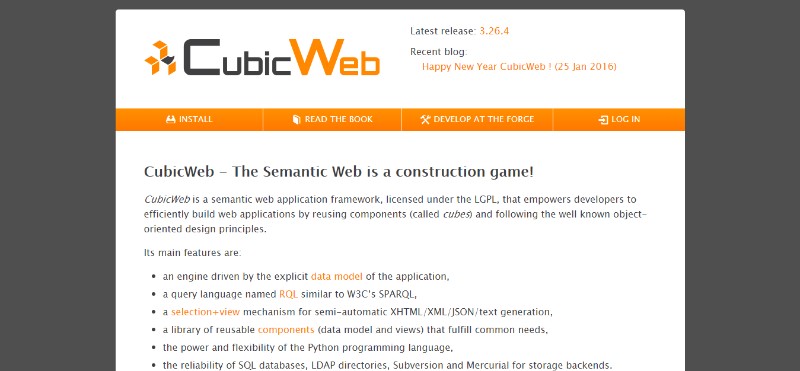
Cubic is an open-source Python framework developed by Logilab and it is based on the data model. Basically, in order to get a functional app, you have to define the data model. It uses cubes joined together to create an instance with the help of some configuration files, a web server, and a database.
The features worth mentioning include:
- Multiple databases, security workflows, and reusable components
- Support for Web Ontology Language (OWL) and Resource Description Framework (RDF)
- Embeds Relational Query Language (RQL) in order to simplify the queries related to data.
Giotto
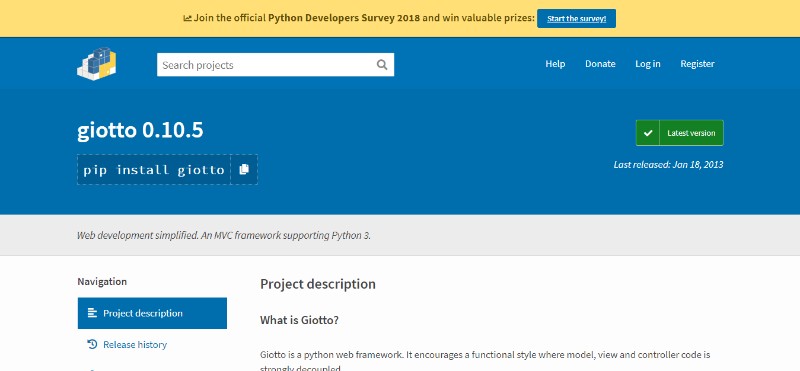
Giotto is another framework for those who use Python in web development. It is an MVC framework which means it separates Model, View, and Controller elements to make it possible for the developers to perform their functions separately and effectively.
In addition to that, it also incorporates controller modules in order to enable users to create applications on top of the web, IRC, or command line.
Pylon
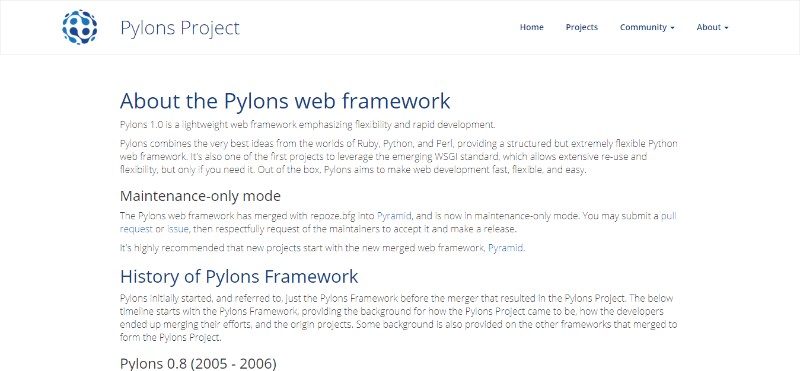
If quick web development in Python is what you are looking for, you should consider using Pylon. It is a lightweight Python framework that incorporates some of the best ideas taken from the programming languages such as Ruby, Perl, and, of course, Python. It is highly flexible and easy to use.
Note: The Pylon framework is in maintenance mode, after being merged with Pyramid to make the Pylons project in order to develop Python-based web technologies.
Non-full-stack Frameworks
The non-full-stack frameworks are ideal for people who want to create small apps or simple websites. They do not provide all of the features and functionalities that come with full-stack frameworks and you need to add a lot of code manually.
The post popular non-full stack Python frameworks include:
Flask
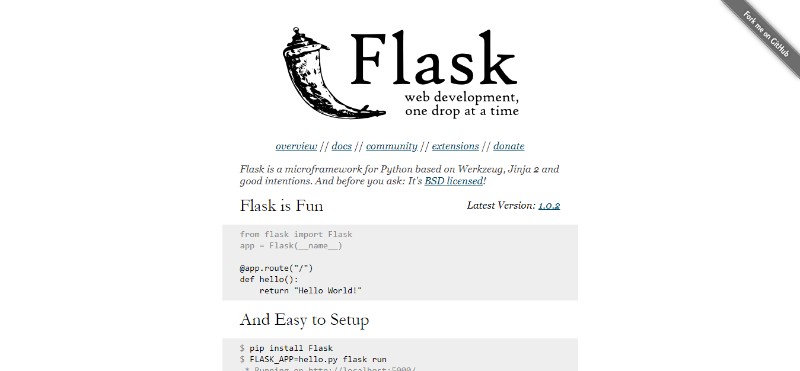
Inspired by the Sinatra Ruby framework, Flask is a Python framework available under the BSD license. It depends on the Werkzeug WSGI toolkit and Jinja2 template.
The main purpose of this simple framework is to build a good app foundation and then grow it with the use of all extensions you might need. It is flexible and easily adaptable to the developers’ needs and the main features include:
- Built-in development server and a fast debugger
- Integrated support for unit testing
- RESTful request dispatching
- Jinja2 templating
- Secure cookies support (client-side sessions)
- WSGI 1.0 compliance
- Unicode-based
- Ability to plug in any ORM
- HTTP request handling
Bottle
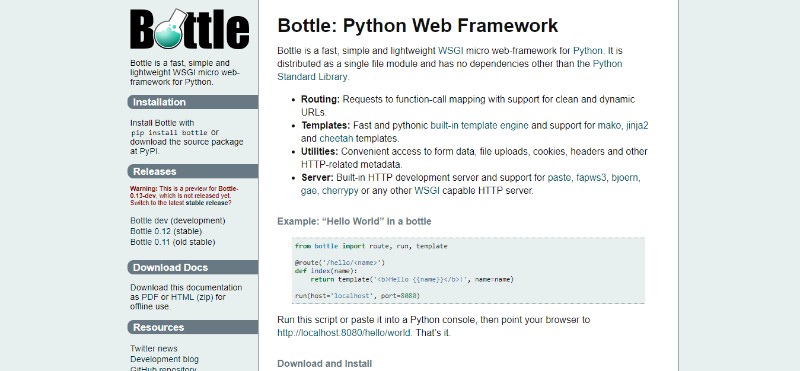
Bottle is a microframework originally designed for building APIs. It implements everything in a single source file and it has no dependencies apart from the Python Standard Library. Bottle’s default features include templating, utilities, routing, and a basic abstraction over the WSGI standard.
- Routing — supports requests to function-call mapping, allowing you to achieve clean and dynamic URLs
- Templates — a fast and Pythonic template engine out of the box along with full support for mako, jinja2, and cheetah
- Utilities — comfortable access to form data, file uploads, cookies, headers, and other HTTP-related metadata
- Server — a built-in HTTP development server that supports fapws3, Bjoern, GAE, СherryPy, and any other WSGI-capable HTTP server
It is a great solution for building prototypes fast and easily.
CherryPy
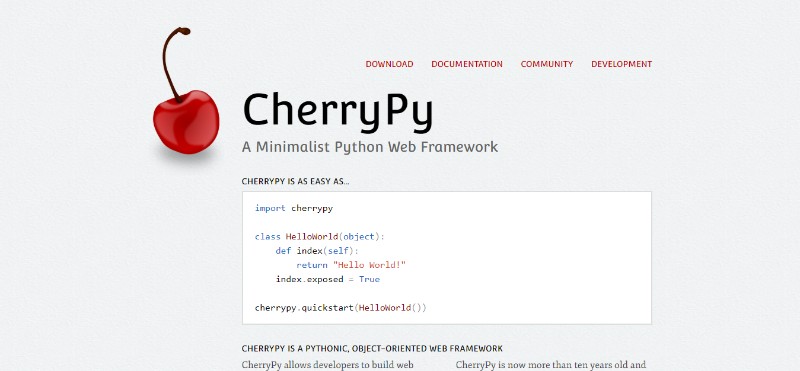
With Django in the first place, CherryPy is the 2nd most popular Python framework. The main difference between the two is that CherryPy doesn’t generate a large amount of template code but it provides a library imported into the project.
It can run several web servers simultaneously and it provides a lot of flexibility to the developers who can enable or disable any variations of templates, databases, and authorization methods.
Moreover, it comes with a very minimalistic environment which is an add-on over the HTTP protocol and allows interaction with all kinds of servers, for instance, Apache.
CherryPy gives you the possibility to configure all the modules of the created software separately, it has a solid plugin repository, and it is great both for beginner developers as well as for seasoned ones.
Tornado
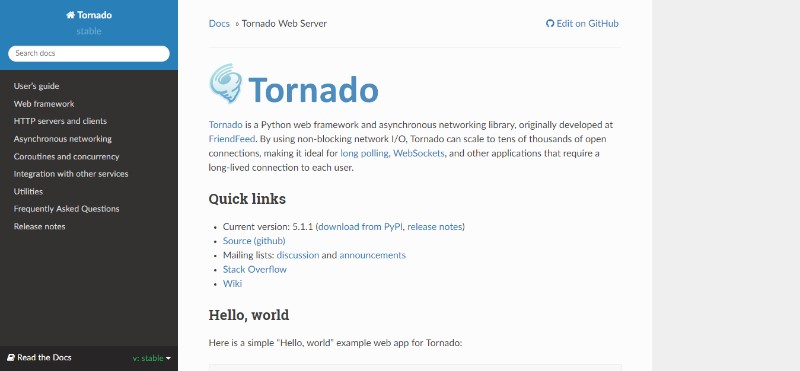
Originally developed at FriendFeed currently owned by Facebook, Tornado is a framework and asynchronous networking library great for Python web programming.
It can scale to tens of thousands of open connections by using the non-blocking network I/O. This makes it perfect for long polling, WebSockets, and other apps that require a long-lived connection to each user.
Falcon
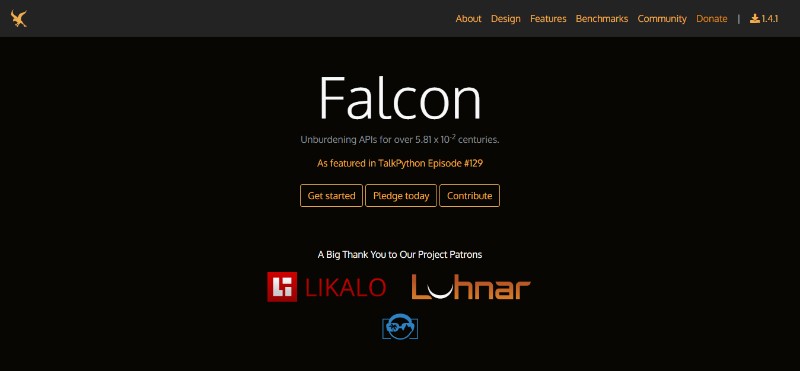
Falcon is microframework great for building higher-level frameworks, Python backend for apps, or small applications themselves. However, keep in mind that it is not suitable for serving HTML pages.
The main features include:
- Highly optimized, extensible code base
- Intuitive routing via URI templates and REST inspired resource classes
- Easy access to headers and bodies through request and response classes
- DRY request processing via middleware components and hooks
- Idiomatic HTTP error responses
- Straightforward exception handling
- Snappy unit testing through WSGI helpers and mocks
- CPython 2.62.7 and 3.3+, or PyPy 2.7 and 3.5+
- Cython support for an extra speed boost under CPython
Sanic
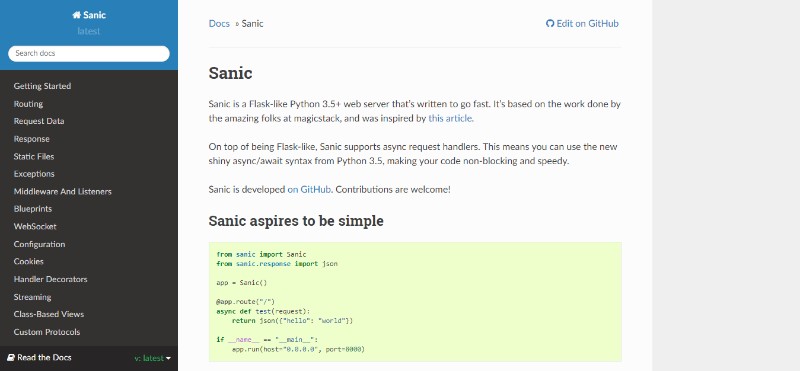
Sanic is built on uvloop and created specifically for fast HTTP responses via asynchronous request handling. It runs on Python 3.5+ and is compatible with its async/await functions thanks to the asynchronous request handlers support. In a benchmark test with one process and 100 connections, Sanic was able to handle 33,342 requests per second.
Zope
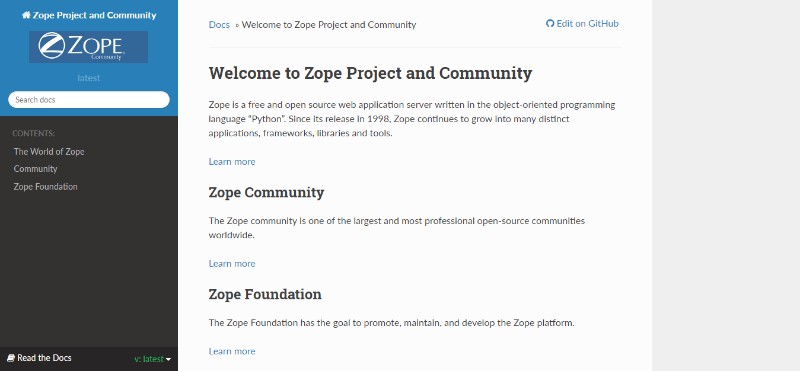
Zope is an open source app server and content management framework for those who use Python for website development. Zope can be extended through Python code to fit the developers’ needs in any way they decide to go.
It is an object-oriented platform with many useful features for building custom web applications in both versions 2.x and 3.x of Python programming language. Moreover, Zope 4 allows developers to take advantage of Chameleon-based page templates and improve the performance of web applications by reducing memory consumption.
Dash
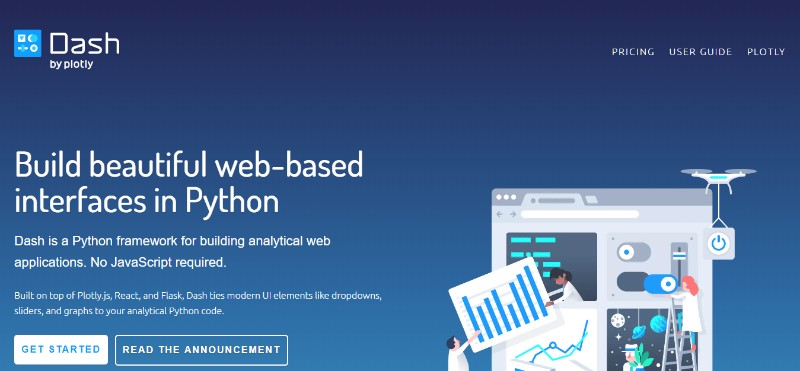
If you are a Python data scientist and not too familiar with web development, Dash is the right open-source framework for web development with Python. Dash applications are web servers that run Flask and communicate with JSON packets over HTTP requests. Their frontend renders components with React.js.
A Python web app built with Dash is inherently cross-platform and mobile-ready because it is rendered in the web browser and then can be deployed to servers. In addition to that, you can use the huge set of Flask Plugins to extend the capabilities of this cool framework even further.
Ending thoughts on the best Python frameworks
There are many great Python frameworks out there which makes it hard to choose the best Python framework. The right way to put things would be by saying that there isn’t such thing as the best framework for website development with Python. In fact, the best one is the one that best fits your needs.
With that in mind, you have to ask yourself what kind of app you’re building, how much time you have to build it, what is your budget, etc. Once you know exactly what you want, it will be much easier to find the right framework that will help you get to your goal.
Start by determining whether you need a full-stack framework or not and then take it from there. Get familiar with all the free Python frameworks out there and pick one based on your preference.
If you enjoyed reading this article on Python frameworks, you should check out this one about Python vs PHP.
We also wrote about a few related subjects like Python web development, web developer interview questions, Python interview questions, Node.js interview questions, React interview questions and best IDE for web development.
